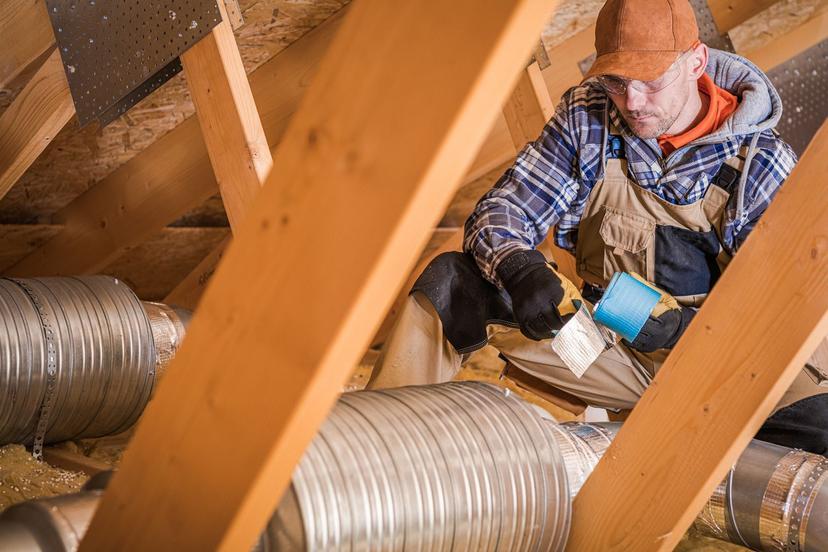A Hidden Danger: Mold in HVAC Systems and Ductwork

Mold thrives in environments with excess moisture, and your HVAC system’s ductwork, evaporator coil, and condensate system provide ideal breeding grounds. Left unaddressed, mold spores can circulate through the ductwork and into your home’s living areas, posing health risks to your family.
HVAC.com provides comprehensive insights into mold in HVAC systems, covering identification, safe removal, and prevention strategies to ensure a healthy and mold-free environment.
What to Know About Mold in Air Ducts and HVAC Systems
Mold growth in outdoor environments is a natural and vital component of ecosystems. However, mold indoors can be dangerous, especially when it’s in your HVAC system. Ductwork can serve as a pathway for distributing mold spores throughout a home’s living areas, potentially worsening indoor air quality issues and increasing the risk of respiratory health problems for occupants.
While most molds only produce dust and allergens that can cause minor respiratory problems, itchy eyes, coughs, sinus problems, some molds that can cause more serious problems. Molds that produce mycotoxins, often referred to as “toxic molds,” can pose severe health risks to individuals. However, it’s important to note that all molds found indoors should be treated seriously and removed promptly.
Being aware of the warning signs of mold in your HVAC system will ensure your family is not breathing unhealthy air.
Identifying Signs of Mold in HVAC Systems
Mold can thrive within HVAC systems where moisture accumulates, such as in ductwork, around evaporator coils, and within drip pans. These dark, damp environments provide ideal conditions for mold to grow and expand, posing potential health risks when the contaminated air is circulated throughout the home.
Mold often reveals itself upon inspection. Develop a routine check for mold into your household maintenance schedule, conducting visual inspections weekly in humid climates and monthly examinations during furnace filter checks in drier conditions.
Look for the following signs that could indicate mold in HVAC systems:
- Water Puddles. A puddle around your HVAC system, even a small one, could signal a clogged condensate drain pipe or broken drip fan which can cause water to accumulate and allow mold to form over time.
- Poor Ventilation. Without proper ventilation and moisture control, these environments become conducive to mold growth, posing risks to both the HVAC system’s efficiency and indoor air quality.
- Visible Signs. Inspect all registers, visible ductwork, evaporator coils, and the condensate system for any visible signs of mold. Coils dehumidify the air and drip the resulting condensation into pans located below. If those coils are working too hard or drip pans are blocked, the resulting moisture becomes a perfect habitat for mold growth.
- Mildew Smell. Your nose can help identify potential signs of mold growth that are not visible. Mold in air ducts gives off a strong mildew smell that spreads throughout the house. If you suddenly start smelling mildew, try turning your system off, waiting 10 to 20 minutes, and then turn it back on. If the smell goes away – or gets weaker – when your system is off and comes back when you turn it back on, you may have mold in your ductwork.
Dealing With Mold in Your HVAC system
If you see or suspect mold in your HVAC system or ductwork, it’s best to contact a professional for HVAC mold removal, especially if it's in the ductwork which is difficult to access. They have the experience and specialized tools to ensure the job is done right.
Additionally, professionals can determine the extent of the mold contamination and identify any underlying issues contributing to its growth, providing homeowners with valuable insights to prevent future mold problems.
Make Appropriate Repairs
After the mold is removed, ensure to correct the cause of the mold to prevent it from returning. In many cases, repairing a clogged condensate drain pipe or a broken drip pan can prevent mold from returning.
Balance Humidity Levels
Elevated indoor humidity levels might indicate that your air conditioning system is old and inefficient. Consider upgrading to a new unit with improved dehumidification capabilities or purchasing a whole-house dehumidifier. Indoor humidity levels should ideally be within a range of 30-50% to discourage mold growth.
Maintain Proper Ventilation
Ensure that your home is adequately ventilated to promote airflow and reduce moisture buildup, which creates a favorable environment for mold growth. To maintain proper ventilation, ensure that your HVAC system is regularly serviced and that you use exhaust fans in kitchens and bathrooms to remove excess moisture.
Regular Maintenance
Schedule routine inspections and maintenance for your HVAC system. During an HVAC maintenance tune-up, a qualified technician can uncover moisture issues that could lead to future mold growth.